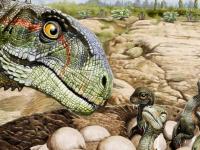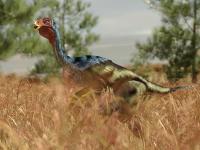Dinosaur-Killing Asteroid Caused Rock To Flow Like Liquid, Scientists Drilling Into Crater Discover

Some 66 million years ago, an enormous asteroid struck Earth with the ferocity of millions of atomic bombs. Up to 10 miles wide, the space rock had a cataclysmic impact on our planet, triggering a mass extinction event that claimed three-quarters of all plants and animals and wiped out large dinosaurs.
Today, millions of years worth of sediment obscures the 100-mile-wide impact crater, which slices through Mexico’s Yucatan Peninsula. Vast swathes of trees and ocean coat the pit, named Chicxulub for a local town.
Now, a craggy ring of broken rock within the pit's rim—the only known “peak ring” of any crater on Earth—has revealed the collision caused incredibly strong vibrations that made hard, arid rocks act like liquid, scientists reported Wednesday in Nature.
When the asteroid tore into the planet, it left an incredibly vast pit with deep, rocky walls. When such walls of rock stretch down 20 miles or more, they can become unstable and give way.
"For a while, the broken rock behaves as a fluid," Jay Melosh, a professor of earth, atmospheric and planetary sciences at Purdue University and one of the study authors, said in a statement.
"There have been a lot of theories proposed about what mechanism allows this fluidization to happen, and now we know it's really strong vibrations shaking the rock constantly enough to allow it to flow."
This behavior causes the mountainous ring to jut out inside the pit within minutes, the scientists wrote. It may be the only peak ring on Earth, but similar craters have been observed on other planets, such as Venus and Mercury. "Large impact cratering...is the most fundamental geological process in our solar system. It formed the planets in the first place, continuously re-shapes the surfaces of terrestrial bodies, generates giant ore deposits and is paramount for the evolution of life on Earth," study author Ulrich Riller of the University of Hamburg told Newsweek in an email.
The patterns, cracks and crevices of a mile-long, six-inch-wide rock core harvested from the Chicxulub crater in six-foot chunks revealed the vibration sequence that led to the weird fluid behavior. "Damaged granite revealed a number of deformation structures, which we were able to relate—for the first time—to individual cratering phases and to the mechanisms by which this large crater formed," Riller said.
The culmination of almost a decade's worth of planning, the core revealed the history of the crater, from post-dinosaur surface rocks to those occurring just after impact, to those brought up from the depths by the collapse of the impact crater, Melosh told Newsweek. "It was indeed an uplifting feeling to see these perfectly preserved rocks for the first time when one after the other section of drill core was split in half," Riller added.
Many more research papers on the historic sample will likely be published over the next few years, Melosh added. The results, the team think, will help researchers understand smaller but much more pressing natural disasters.
Rock behaves like fluid in landslides for example, Melosh said in the statement. “Towns have been wiped out by enormous landslides, where people thought they were safe but then discovered that rock will flow like liquid when some disturbance sets a big enough mass in motion."
In other geology news, scientists have been mapping an enormous cave complex discovered under a sinkhole in China. The “world-class” cave hall, they discovered, contains craters, pillars, corridors, and round rocks called cave pearls.
An ancient pit in the permafrost of Siberia continues to yield incredible scientific finds. Researchers recently unearthed a mammoth and even a well-preserved horse from the “Mouth of Hell” crater.
Source: www.newsweek.com








